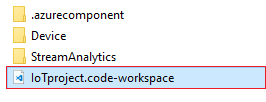Welcome to Azure IoT Device Workbench preview for Visual Studio Code! The Azure IoT Device Workbench extension makes it easy to code, build, deploy and debug your IoT project with multiple Azure services and popular IoT development boards .
Azure IoT Device Workbench aims to support multiple popular IoT development boards and kits. It currently supports following IoT hardware:
Please find the Setup Guide section below to configure your hardware.
We will support more devices in Azure IoT Device Workbench. Please help to take the survey to let us know your opinion of the device.
Open VS Code and press F1 or Ctrl + Shift + P to open command palette, select Install Extension and type iot-workbench.
Or launch VS Code Quick Open (Ctrl + P), paste the following command, and press enter.
ext install vscode-iot-workbenchAfter installation, please reload the window and make sure all the dependency extensions are correctly installed.
Currently this extension supports the following operatings systems:
- Windows 7 and later (32-bit and 64-bit)
- macOS 10.10 and later
Please follow the guide to setup IoT DevKit.
Here are a set of tutorials that will help you get started:
- Get Started
- Shake, Shake for a Tweet
- Remote Monitoring
- DevKit Translator
- MQTT Client
- DevKit State
- Door Monitor
- DevKit DPS
- DevKit OTA
- Stream Analytics and Cosmos DB
Here are a set of tutorials that will help you get started:
Here are a set of tutorials that will help you get started:
Please follow the guide to setup ESP32 device.
Here are a set of tutorials that will help you get started:
| Command | Description |
|---|---|
Azure IoT Device Workbench: Create Project... |
Create new IoT Device Workbench projects. |
Azure IoT Device Workbench: Open Examples... |
Load existing examples of IoT Device Workbench project. |
Azure IoT Device Workbench: Provision Azure Services... |
Provison Azure services for current project. |
Azure IoT Device Workbench: Deploy to Azure... |
Deploy the code of the Azure services. |
Azure IoT Device Workbench: Compile Device Code |
Compile device code. |
Azure IoT Device Workbench: Upload Device Code |
Compile and upload device code. |
Azure IoT Device Workbench: Configure Device Settings... |
Manage the settings on the device. |
Azure IoT Device Workbench: Install Device Compiler Toolchain... |
Install device compiler toolchain. |
Azure IoT Device Workbench: Set Workbench Path |
Set the default path for Azure IoT Device Workbench. |
Azure IoT Device Workbench: Help |
Get help for Azure IoT Device Workbench. |
- When invoking the Azure IoT Device Workbench: Provision Azure Services... command with Azure IoT Hub and Azure Functions, by default, Azure Functions would use the IoT Hub consumer group of
$Default. To switch to another consumer group, please follow the guide to create a new consumer group in Azure Portal. Then in IoT project, modify the following setting in function.json:"consumerGroup": "[consumer_group_name]" - You may open an existing IoT project after you close it. To do so:
The Microsft Enterprise and Developer Privacy Statement describes the privacy statement of this software.
There are a couple of ways you can contribute to this repo:
-
Ideas, feature requests and bugs: We are open to all ideas and we want to get rid of bugs! Use the Issues section to either report a new issue, provide your ideas or contribute to existing threads.
-
Documentation: Found a typo or strangely worded sentences? Submit a PR!
-
Code: Contribute bug fixes, features or design changes:
- Clone the repository locally and open in VS Code.
- Install TSLint for Visual Studio Code.
- Open the terminal (press
Ctrl + `) and runnpm install. - To build, press
F1and type inTasks: Run Build Task. - Debug: press
F5to start debugging the extension. - Run
gts checkandgts fixto follow TypeScript style guide.
-
Example: Contribute examples for the supported devices.
-
Create a git repo to host the code of your example project.
-
Write a tutorial to describe how to run the example.
-
Submit a new issue and provide the following information:
Item Description NameName of the example to be displayed in example gallery. DescriptionA short statement to describe the example. LocationURL of the GitHub repo. ImageURL of the example image (size: 640*370) shown in the gallery, if not provided, the default image will be used. TutorialURL of tutorial that describes how to run the example. DifficultyDifficulty of the example, easy, medium or difficult.
-
This project has adopted the Microsoft Open Source Code of Conduct. For more information please see the Code of Conduct FAQ or contact opencode@microsoft.com with any additional questions or comments.
If you would like to help to build the best IoT experience with Azure IoT Device Workbench, you can reach us directly at gitter chat room.
VS Code collects usage data and sends it to Microsoft to help improve our products and services. Read our privacy statement to learn more. If you don’t wish to send usage data to Microsoft, you can set the telemetry.enableTelemetry setting to false. Learn more in our FAQ.




